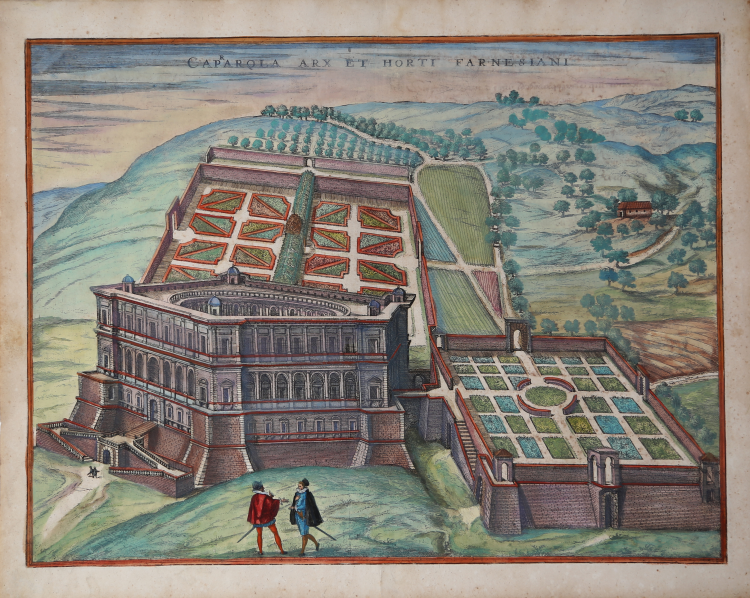




| Reference: | S49238.220 |
| Author | Georg BRAUN & Franz HOGENBERG |
| Year: | 1596 ca. |
| Zone: | Caprarola |
| Printed: | Antwerpen & Cologne |
| Measures: | 500 x 380 mm |



| Reference: | S49238.220 |
| Author | Georg BRAUN & Franz HOGENBERG |
| Year: | 1596 ca. |
| Zone: | Caprarola |
| Printed: | Antwerpen & Cologne |
| Measures: | 500 x 380 mm |
A view of Farnese Palace in Caprarola (Latium) by Braun and Hogenberg.
"The magnificent palace of Caprarola, which is laid out in the shape of a pentagon on Monte Cimini, today lies in the Lago di Vico nature reserve. It was commissioned by Cardinal Alessandro Farnese - grandson of the notoriously nepotistic Pope Paul III - from the Bolognese architect Giacomo Barozzi da Vignola in 1559. Caprarola palace, also known as the Villa Farnese, is seen in cavalier perspective, allowing the viewer a partial glimpse into the circular inner courtyard of the massive pentagonal complex. Inside the courtyard are splendid colonnades, within which columned niches house the busts of Roman emperors. The magnificent gardens can also be admired in the engraving. The massive Villa Farnese is considered one of the finest examples of Renaissance architecture. The building, which dominates the surrounding countryside, is characterized by its strict proportions and sparing ornamentation. After Farnese's death (1589) the villa passed to the Dukes of Parma and received little use. In the 19th century the villa served for a while as the residence of the heir to the throne of the Kingdom of Italy; today it is the occasional home of the Italian president. In 1580 Montaigne praised the building as the most beautiful palace in Italy, a compliment that probably inspired Braun and Hogenberg to include it in their city atlas". (Taschen).
The work is included in the Civitates Orbis Terrarum, the first atlas devoted exclusively to plans and views of the world's major cities. Printed in six volumes between 1572 and 1617 it was so successful and widespread that several editions translated into Latin, German and French were printed.
The first volume of the Civitates Orbis Terrarum was published in Cologne in 1572. The sixth and the final volume appeared in 1617. This great city atlas, edited by Georg Braun and largely engraved by Franz Hogenberg, eventually contained 546 prospects, bird-eye views and map views of cities from all over the world. Fransz Hogenberg produced the plates for the first four books, and Simon van den Neuwel (Novellanus, active since 1580) those for volumes V and VI.
Georg Braun (1541-1622), a cleric of Cologne, was the principal editor of the work, and was greatly assisted in his project by the close, and continued interest of Abraham Ortelius, whose Theatrum Orbis Terrarum of 1570 was, as a systematic and comprehensive collection of maps of uniform style, the first true atlas. The Civitates, indeed, was intended as a companion for the Theatrum, as indicated by the similarity in the titles and by contemporary references regarding the complementary nature of two works. Nevertheless, the Civitates was designs to be more popular in approach, no doubt because the novelty of a collection of city plans and views represented a more hazardous commercial undertaking than a world atlas, for which there had been a number of successful precedents. Franz Hogenberg (1535-1590) was the son of a Munich engraves who settled in Malines. He engraved most of the plates for Ortelius's Theatrum and the majority of those in the Civitates, and may have been responsible for originating the project.
Over a hundred of different artists and cartographers, the most significant of whom was Antwerp artist Georg Hoefnagel (1542-1600), engraved the cooper-plates of the Civitates from drawings. He not only contributed most of the original material for the Spanish and Italian towns but also reworked and modified those of other contributors. After Hoefnagel's death his son Jakob continued the work for the Civitates.
The author set out to depict "non icones et typi urbium," that is, not generic and typified images, "sed urbes ipsae admirabili caelaturae artificio, spectantium oculis subiectae appareant": not intended to allude or idealize but to represent faithfully on paper, to reproduce exactly, and in real time, what the eye sees, as announced in the preface to the first volume of Civitates Orbis Terrarum.
Etching on copperplate, with original hand colour, in very good conditions.
|
Van der Krogt 4, 781 State 2; Taschen, Br. Hog., p.421.
|
|
George Braun (1541-1622), cleric of Cologne, was the principal editor of the Civitates Orbis Terrarum, and was greatly assisted in his project by the close, and continued interest of Abraham Ortelius, whose Theatrum Orbis Terrarum of 1570 was, as a systematic and comprehensive collection of maps of uniform style, the first true atlas.
Franz Hogenberg (1535-1590) was the son of a Munich engraves who settled in Malines. He engraved most of the plates for Ortelius's Theatrum and the majority of those in the Civitates, and may have been responsible for originating the project.
|
|
Van der Krogt 4, 781 State 2; Taschen, Br. Hog., p.421.
|
|
George Braun (1541-1622), cleric of Cologne, was the principal editor of the Civitates Orbis Terrarum, and was greatly assisted in his project by the close, and continued interest of Abraham Ortelius, whose Theatrum Orbis Terrarum of 1570 was, as a systematic and comprehensive collection of maps of uniform style, the first true atlas.
Franz Hogenberg (1535-1590) was the son of a Munich engraves who settled in Malines. He engraved most of the plates for Ortelius's Theatrum and the majority of those in the Civitates, and may have been responsible for originating the project.
|